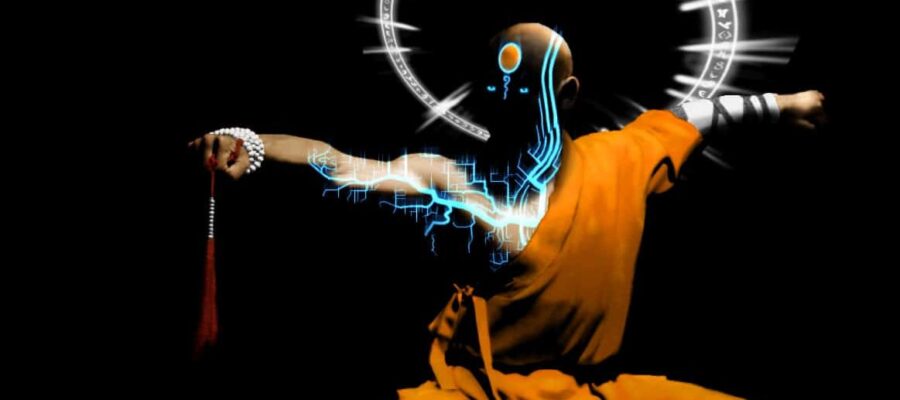D&D 5e Monk feats featured art “I am Shaolin” by
IamTheWay. Creative Commons License.
This article contains affiliate links that add gold to our coffers.
Welcome to my monastery of the best feats for Monks in D&D 5e; I’ll reveal the premium feats to develop the martial artist you’ve trained to become. Feats are powerful customizations when coupled wisely with class abilities. Some feats are better than others, so I’ll direct you to Monk feats that are worth your character’s time to learn.
Feats are spread out through several books, making it difficult to settle on 5e’s best Monk feats. I’m providing a noble service by summarizing the best feats and warning against several duds. The goal is to help you have as much as possible with your Monastic Tradition! My feat recommendations come from officially published sources (PHB, TCoE, and XGtE, with Elemental Evil referenced for Svirfneblin Magic).
Considerations for Selecting Monk Feats
The Monk class is notoriously MAD: Multiple Ability (Score) Dependent. This means Monks want several ability scores to be high to take full advantage of their class abilities. Monks typically want high Wisdom and Dexterity while still investing a bit in Constitution. This dependence on ability scores will make it difficult to justify taking a feat if boosting a stat by two could be better. Feats that also boost stats will be extra important to a Monk.
Another challenge with Monk feats is not to bog down the already-busy action economy of the Monk. Bonus actions are used for various Monk abilities, including unarmed strikes. Monks may use reactions to Deflect Missiles, opportunity attacks, and Slow Fall. Since Monks have no problems utilizing their action economy, feats are more attractive when they provide passive bonuses. You could argue that it’s good to have options that don’t use Ki, so I might touch on diversifying what you can do (probably not in the ‘best’ feats list, though).
I’ve organized my feat suggestions by best, middling, niche, and worst feats for Monks. The best feats will reliably make your Monk better at what Monks tend to do. Acceptable feats may not be as universally useful as the best feats, but you might prefer them. Niche feats will have value to specific Monastic Traditions or campaign genres. I bothered to list the “trap” feats because I want to point out feats that might seem good but actually are not (character traps).
With the premise out of the way, here is my guide to selecting feats for your Monk!
Best Monk Feats of D&D 5e (Ranked)
#1 Crusher
Increase your Constitution stat by one. You could increase your Strength instead if you’re going for an unconventional Strength-based Monk. Crusher allows you to push enemies around or even shove them off ledges as a passive part of one attack per round. Your attacks can save your allies from enemy opportunity attacks by knocking enemies away. Once pushed, enemies won’t be in range to threaten opportunity attacks so your allies can freely move away without spending actions to Disengage.
Combining this with the Sentinel feat will allow you to reduce enemy movement speed to zero when you land an opportunity attack. That same opportunity attack can push them away from you while their speed is reduced to zero, meaning they won’t be adjacent to you anymore. You can potentially isolate them for their whole turn! Your teamwork will also improve by opening an enemy to attacks with advantage after landing a critical hit, but that may be less important if you succeed with a Stunning Strike to stun the target.
#2 Mobile
Your action economy opens up when you can freely move away from enemies. The speed boost is nice, too. Monks quickly gain the highest movement speed of the basic classes, so freeing yourself up to use that movement is important. Attack an enemy before moving away, forcing them to chase you down. Your high movement speed will make it difficult or impossible for them to keep up. Any enemy who is only using melee attacks will be frustrated quickly by your speed and kiting.
#3 Sentinel
With great mobility comes great responsibility. You have some of the best tools in the game to get into tactical positions in combat. You can stick close to your allies to retaliate against their assailants, or you can keep one enemy in place as you go toe-to-toe. Sentinel’s ability to reduce an enemy’s movement speed to zero is the most important feature for a Monk. You can prevent one enemy from leaving your side after you nimbly approach. You can take away their chance to attack you after losing their movement speed by using Crusher to push them away from you. It’s an awesome combination for locking down a bruiser.
#4 Fey Touched
You can boost your Wisdom while gaining spells. Misty Step will always have opportunities to be used, such as when you must quickly get through a window, over a chasm, or out of an ogre’s headlock hold. The first-level spell of choice can be Bless, Hunter’s Mark, or Hex. The latter two spell options will enable you to boost your damage output against big foes who will take a few rounds to smack around. Hex is more useful if you’re relying on grappling or hiding, while Hunter’s Mark never allows a foe to escape untracked. Gift of Alacrity wouldn’t be bad either since you can cast it without concentration for eight hours ahead of an adventuring day.
#5 Elven Accuracy
(Elves and Half-elves only) Increase your Dexterity or Wisdom. Gain “triple advantage” when you attack with your Dexterity with advantage. This feat couples well with the Crusher feat since you’ll gain advantage after landing critical hits. The racial limitation can obviously make this feat inaccessible to many characters, but characters with Elven blood can enjoy it.
You should probably boost your Dexterity or Wisdom before taking a feat that isn’t on my list of top five feat recommendations. However, maybe you’d rather have some fun instead of padding your statistical chances for success, so continue reading for other ideas!
Acceptable Feats for Monks
Acceptable feats may not be as universally useful as the best feats, but you might prefer them. I’ll explain why they may still be useful for your character, depending on your concept.
Lucky: It’s the boring feat that is always a consideration. There isn’t a character alive who couldn’t use Lucky. I won’t recommend it as the best feat, but it’s always on the radar if your stats are high enough and you don’t like other feat options. Its simplicity is attractive to players who already have enough character options to remember.
Magic Initiate: This is a little clunky, but it can improve your damage output and give you interesting spells. Taking the Hex spell will allow you to deal extra damage on each of your 3-4 attacks in an average round after level five for +4d6 damage per round while concentrating and not switching targets. It’ll take a bonus action to set up, so your unarmed strikes won’t let loose until round two.
You can learn Booming Blade to use your action while you’re kiting enemies with your Mobile feat (not a DPR boost, but can make them want to stay in place). You won’t have to sacrifice your unarmed attacks either because of the new Ki-Fueled Attack Monk feature in Tasha’s Cauldron of Everything. Use your Stunning Strike as part of the Booming Blade attack (since you didn’t technically use the Attack action), and the use of that Ki will allow you to make an unarmed attack. You’ll compare this feat to the Fey Touched feat I recommended. Kinda neat, though not optimal.
Observant: Perception is a clutch skill to be good at, so boosting your Passive Perception +5 is huge. The stat boost that comes with it can go to your Wisdom for a potential value +6 to your Perception from this feat. It’s not the top priority, but some players enjoy being so perceptive that nothing slips by them.
Sharpshooter: Kensei subclassed Monks will enjoy using a longbow to snipe enemies for extra damage. This used to be the only Monastic Tradition that I could recommend to choose Sharpshooter, but Tasha’s Cauldron of Everything introduced the Dedicated Weapon option for all Monks. Dedicated Weapon allows Monks to use simple weapons like shortbows and slings as Monk Weapons for Martial Arts compatibility. You’ll be keeping your distance from enemies, so you won’t make unarmed attacks or use Stunning Strike; the trade-off is that you can use Patient Defense as a bonus action while relying on Deflect Missiles to deal with incoming ranged attacks. Know the pros and cons if you want to play a Monk this way.
Squat Nimbleness: (Dwarves or Small Races only) Increase your Dexterity and offset your race’s slower movement speed. I’d still prefer to take the Mobile feat first for its kiting power, but I can imagine a build where I might take Squat Nimbleness after Mobile.
Niche Feats for Monks
Niche feats add value to specific Monastic Traditions or campaign styles. They may not be ubiquitous in their usefulness, but they’ll do well with the right character build and applicable campaign style.
Alert: My observation has been that many DMs don’t spring surprise ambushes on player characters, so this feat has become niche to me over the years. The Initiative boost +5 is awesome, though. Monks want to be swift, and acting first can allow them to get into position before losing their openings. Move first, rush into a position, lock down the most threatening enemy’s movement—couples well with Sentinel.
Fighting Initiate: If you’re getting a feat at level one as a Variant Human or with a Custom Lineage, start with the Unarmed Fighting style to boost your unarmed attack damage. Switch your Fighting Style later when your Martial Arts surpass the Unarmed Fighting Style. The new Fighting Style should fit the way you play your Monk, so I imagine you’ll choose Blind Fighting or Dueling.
Mage Slayer: Become a nuisance to any spellcaster to whom you decide to stick; you’re the Dennis Rodman of Monks. Spellcasters will struggle to concentrate when facing your Flurry of Blows, and you’ll have advantage against their saving throws in close quarters. You’ll eventually have Diamond Soul to fortify your saving throws further. I probably wouldn’t double this up with the Sentinel feat since they’d compete with one another for reactions.
Telekinetic: Boost your Wisdom and enjoy this feat’s utility for moving people and objects. It uses your bonus action, so it won’t often be as good as making unarmed attacks. If you’re playing a Way of the Four Elements Monk, you might be interested in this spell-like feat to augment your elemental casting.
Trap Feats for Monks (Don’t Pick)
Trap feats may not be bad feats on their own (some are), but that’s why I call them traps. For Monks, they can seem good but actually be detrimental. I’ll explain why for each of them.
Athlete: This may be tempting since you can boost your Dexterity, but the main benefits are redundant or unnecessary for Monks. You’ll eventually be running up walls without climbing. Getting up from being prone to save your movement speed may not matter since your speed will be high.
Defensive Duelist: This feat is tempting if you’re using a finesse weapon, like a scimitar. The deception lies in that Monks have the mobility to stay out of trouble. The feats on my ‘best’ list will outperform Defensive Duelist because most of them are designed to help you kite enemies. Keeping your distance will mean your enemies aren’t attacking you at all. Save your reaction for catching projectiles if you’re keeping your distance or attacking with Sentinel and opportunity attacks if you’ve remained close to your target. Pick some of the better feats that I described earlier, or boost your stats.
Dual Wielder: Monks can’t use their unarmored features if they use shields, so it may be tempting to boost AC +1 with Dual Wielder while enhancing your fighting. It won’t work, and you’re better off boosting your Dexterity or Wisdom if you want to improve your defenses. Monks already utilize bonus actions for attacking, so there’s literally no reason to dual-wield melee weapons.
Resilient: Diamond Soul will negate this feat. You’re going to be proficient with all saving throws, so don’t worry about the usually good Resilient feat.
Wood Elf Magic: (Wood Elves only) Longstrider will be like half of a Mobile feat with a duration that can be dispelled. You won’t get a stat boost. Pass without Trace is a good spell, but you should leave that to someone else in the party who won’t need a feat to cast it. Players used to love picking Wood Elves as Monks, and they probably still do. Don’t pick this feat, though.
Conclusion
If you’ve learned nothing else from this article, I hope you’ve learned that Crusher and Mobile are invaluable feats for a Monk. They’re among the best feats for Monks in D&D 5e. My recommendations are grounded in experience, game mechanics, and metagame knowledge. I tried to categorize and describe them in a way that explains assumptions and subjective points. I’m confident that you’ve learned how to choose Monk feats wisely by exploring my summary so that I can rest easy.
Tell me: which feats have I been fair or unfair to? In the comments section below, cast Message to communicate if you agree with my recommendations or passionately disagree. I’ve been wrong before, so you should consider it a challenge to find any mistakes I’ve made in my analysis! Thank you again for reading. I hope you’ll share this article with your friends to get a discussion started.
Oh, it seems you possess a high Passive Perception score. Before you go, take these secret passageways to discover more content about feats and character concepts!





The Crusher feat doesn’t work combined with Sentinel the way you think it does. That’s because leaving someone’s reach provokes opportunity attacks only if the target tried to leave using his own movement; which means: you cannot make an opportunity attack at someone you just pushed away from you.
Still a valid feat tho
Hi Jackson, I’m not sure you understood my point. When you make an attack with a reaction from the Sentinel feat, you can also push the enemy away from you with the attack. This means the enemy’s movement drops to zero and they’re out of reach to attack you while they’re stuck there.
Yeah, I only thought afterwards you may have meant that, but at that point I couldn’t change my comment. It’s just just that it’s not compleately clear the way it’s written, imho. Sorry for the misunderstanding
I will revise my wording to make it clearer 🙂
what about piercer ?
distance / throw / finesse weapon ?
I’m sure you could make it work, but it doesn’t stick out as transformative to me. I like the idea of using thrown weapons as a Monk though! That’s fun.
Hello, thanks for this helpful guide! I have a question and I wonder if you have any thoughts: As a Way of the Open Hand monk (wielding a quarterstaff), is it worthwhile having both Crusher and Mobile? (Ignoring the opportunity cost, i.e. ignoring other things you can do instead of taking a feat, imagine you’re just being gifted two feats.) I ask because it seems like they have a similar function in enabling you to get away from enemies in melee without taking an opportunity attack – with Crusher you push the enemy away from you and then run away without taking an opportunity attack because you’re no longer adjacent; with Mobile you hit the enemy and then run away without taking an opportunity attack because of the feat. I know each of these feats does other good things too but I was wondering what you think about whether each of them negates the value of the other too much to make it worth having both. Thanks!
Great question, Nora! To an extent, you’re right. There is overlap/redundancy between the feats. However, Mobile is useful if you need to hit multiple enemies and move away. Crusher only works on one creature per turn, so it’s only useful against single enemies. Additionally, Crusher’s knockback effect doesn’t work on creatures that are more than one size larger than you. These limitations to Crusher still allow Mobile to shine.
Now when we factor in that you’re playing an Open Hand Monk, we need to consider that the Open Hand Technique creates more redundancies when it uses ki to make Flurry of Blows attacks. This is because Open Hand Technique can knock back and remove reactions (no opportunity attacks coming your way). It does cost ki though. I believe the best use of ki is to attempt Stunning Strike, and your ki can become depleted very quickly. I think Crusher and Mobile can still be useful for an Open Hand Monk because they can help the character conserve ki points.
Additionally, Monks aren’t super compatible with many feats. If you can think of something that would be more useful, you could certainly justify omitting Mobile or Crusher to pick something else. Just remember you’ll probably use more ki on your Stunning Strikes and other ki-fueled abilities that allow you to get in and get out of a skirmish.
Your Booming Blade technique is oxymoronic. In order to trigger the secondary damage, they enemy has to WILLINGLY move. If you use Stunning Strike as part of that, it completely negates the secondary damage as they are stunned. In which case, you’re actually lowering your DPS. You would be better off to just make a regular attack (at LV5 you get two of, and can still make your unarmed strike as BA), or go for Green Flame Blade which would still see extra damage on another enemy. Even then, you’re still losing DPS, if you take the Attack action and land a Stunning Strike on the first attack, the subsequent two attacks are both at advantage due to the stun. I’m not saying Magic Initiate is a bad feat to take, Booming Blade is just a poor choice to take. Better off with something like like Green Flame Blade or something more utility in nature
Well said! I personally wouldn’t pick Magic Initiate for a Monk. I also haven’t played a Monk in six years or so. I updated the article to be more upfront about the pros and cons.